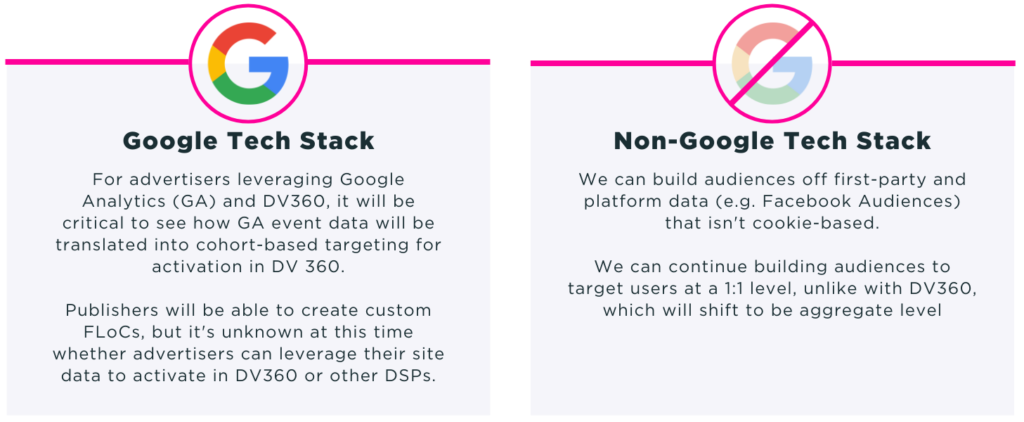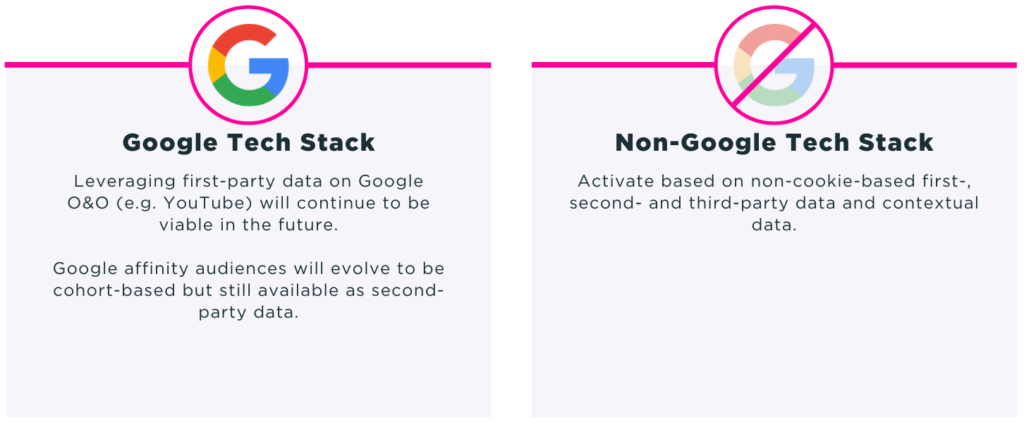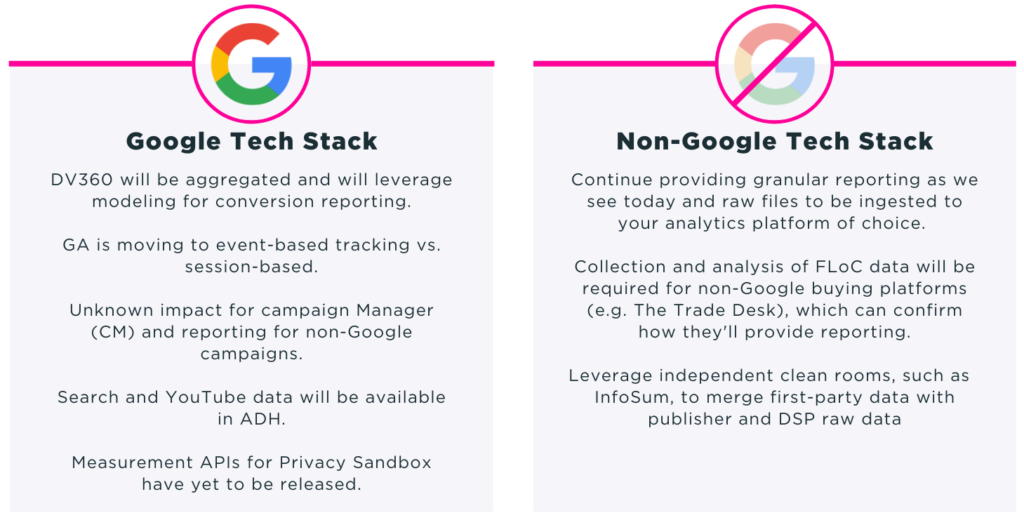Asking the right questions pre-cookie loss in 2023
Since Chrome’s January 2020 announcement that it would stop supporting third-party cookies within two years (which was pushed to the end of 2023 this past June), the industry has talked non stop about cookie loss.
The irony is that we had already lost third-party cookies from approximately 40% of users since Apple Safari and Mozilla Firefox eliminated them in 2018.
Back then, the impact was mitigated by advertisers having the alternative of running all media on Chrome browsers.
But with Chrome now also deprecating third-party cookies, the pressure is on to find solutions, which are being built out in real time.
It’s highly likely that advertisers will need a variety of solutions to meet their business goals.
So what areas are impacted?
1. Data collection
Changes to Chrome don’t directly affect first-party data collected on-site, but pixels will become obsolete. Any partners that currently use a pixel on your site will need to provide an alternative solution if they want to continue using your site data.
Take Facebook, which currently has a pixel on all advertiser sites for measurement purposes. To continue proving the value of its advertising, the company has released the Conversions API to facilitate usage of site data.
APIs are a safe way to share data from one place to another, and they give advertisers the most control. We expect to see most vendors move to APIs or server-to-server integrations as pixels dwindle.
2. Audience segmentation
As first-party data continues to grow in importance, building audiences based on first-party data, connected to an ID, will be critical. When collecting data, advertisers need to ensure they have consent—both to comply with regulations and to build trust with users.
Clean data results in clean findings, ultimately providing the best user experience and the most powerful analytics.
If your first-party data is limited, you can lean into aggregate-level platform data from sources such as Google, Facebook, and Amazon to help replace cookie-based segments.
3. Targeting
With third-party cookies finally crumbling, four kinds of data will hold the key to targeting, measurement, and attribution going forward: first-party, second-party, third-party, and contextual.
To find potential consumers and reach existing ones, advertisers will need to be flexible about which data sets to leverage for specific use cases and how to combine them.
Check out “How marketers can achieve scale and precision in a world without third-party cookies” to dive deeper into these four types of data and put them into practice.
4. Optimizations
The efficacy of optimizing based on aggregated browser groups in Google’s DV360 is unknown until we can test in early 2023. We don’t anticipate much change to optimization strategies on independent buying platforms.
5. Performance
This is the biggest unknown for all future solutions. It requires testing of identity solutions that could meet your business goals. Potential solutions include ID5, Unified ID 2.0, Google Chrome APIs, and contextual partners.
Since there isn’t a one-size-fits-all approach for the future, brands need to explore and test new identity solutions and alternative targeting tactics.
Specifically, you should identify how non-cookie-based levers can help optimize a media investment and leverage A/B testing.
This will help you determine whether aggregate-level solutions are as effective as cookie-based and 1:1 targeting solutions.
6. Measurement & attribution
Today’s metrics will need to be reevaluated, with different mechanisms and levels of granularity required, to provide measurement and attribution in the future.
Cookies currently provide a way to combine reporting across much of your activity, and without them, we have multiple campaign elements to stitch together. Basic delivery metrics, such as reach, will go from being campaign-focused to increasingly being managed on a platform-by-platform basis. Frequency and frequency capping will move from user level to aggregated.
Conversion reporting will also see a change. We won’t be able to map a conversion event back to an individual in any scenario.
What’s proposed is a blend of aggregate-level data that summarizes conversions across a group, with “noise” added to further protect privacy.
First-party data will continue to be the source of truth for understanding conversions, though mapping it back to media will be a challenge.
Navigating uncertainty
There are still a lot of unknowns, but we’re asking the right questions leading up to the second half of 2023.
It’s important to make the most of the 18 months remaining and rigorously assess your data collection strategies and processes, data and technology partners, audience sources, curation processes and analytics platforms and outputs.
We’re all in this together. Without a silver bullet solution, the industry is in a collective state of uncertainty. Advertisers, publishers and agencies will have to continually educate themselves on the changes and test and learn to find the right combination of solutions.




